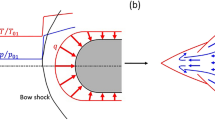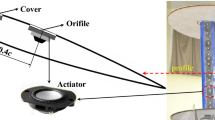Abstract
A novel circulation control technique is proposed to overcome the shortcomings of blowing jet circulation control, which uses the synthetic jet as the actuator and avoids the limitation about air supply requirement. The effectiveness of synthetic jet circulation control to enhance lift of NCCR1510-7067N airfoil is confirmed by solving the 2-D unsteady Reynolds-averaged Navier-Stokes equations. The aerodynamic characteristics and the flow structure (especially close to the trailing edge) of NCCR1510-7067N airfoil at zero angle of attack are also presented to discuss the mechanism of lift enhancement of the airfoil with synthetic jet circulation control. The results indicate that the synthetic jet can effectively delay the separation point on the airfoil trailing edge and increase the circulation and lift of the airfoil by Coanda effect. The numerical simulation results demonstrate that the lift augmentation efficiency with synthetic jet circulation control reaches ΔC L /C µ=114 in the present study, which is much higher than the value 12.1 in the case with steady blowing jet circulation control.
Similar content being viewed by others
References
Coanda H. Device for Deflecting a Stream of Elastic Fluid Projected into an Elastic Fluid. US Patent No. 2052869, 1936
Englar R J, Williams R M. Test techniques for high lift, two-dimensional airfoils with boundary layer and circulation control for application to rotary wing aircraft. Can Aeronaut Space J, 1973, 19(3): 93–108
Englar R J. Overview of circulation control pneumatic aerodynamics: Blown force and moment augmentation and modification as applied primarily to fixed-wing aircraft. In: Proceedings of the 2004 NASA/ONR Circulation Control Workshop, Part 1, NASA/Office of Naval Research, 2004. 37–99
Englar R J, Marilyn J S, Sean M K, et al. Development of circulation control technology for application to advanced subsonic transport aircraft, Part I: airfoil development. J Aircraft, 1994, 31(5): 1160–1177
Englar R J, Niebur J S, Gregory S D. Pneumatic lift and control surface technology for high speed civil transports. J Aircraft, 1999, 36(2): 332–339
Liu Y. Numerical Simulation of the Aerodynamic Characteristics of Circulation Control Wing Sections. Dissertation of Doctoral Degree. Atlanta: Georgia Institute of Technology, 2003
Jones G S, Englar R J. Advances in pneumatic controlled high lift systems through pulsed blowing. AIAA Paper 2003-3411, 2003
Jones A, Edstrand A, Chandran M, et al. An experimental investigation of unsteady and steady circulation control for an elliptical airfoil. AIAA Paper 2010-346, 2010
Rich P, McKinley B, Jones G S. Circulation control in NASA’s vehicle systems program. In: Proceedings of the 2004 NASA/ONR Circulation Control Workshop, Part 1, NASA/Office of Naval Research, 2004. 1–36
John L L. Why have only two circulation-controlled STOL aircraft been built and flown in years 1974–2004. In: Proceedings of the 2004 NASA/ONR Circulation Control Workshop, Part 1, NASA/Office of Naval Research, 2004. 603–622
Zha G C, Paxton C. A novel flow control method for airfoil performance enhancement using co-flow jet. In: Joslin R D, Jones G S, eds. Applications of Circulation Control Technologies. Progress in Aeronautics and Astronautics. AIAA Book Series, AIAA, 2006, 214: 293–314
Corke T C, Post M L, Orlov D M. SDBD plasma enhanced aerodynamics: Concepts, optimization and applications. Prog Aerosp Sci, 2007, 43(7–8): 193–217
Greenblatt D, Kastantin Y, Nayeri C N, et al. Delta wing flow control using dielectric barrier discharge actuators. AIAA J, 2008, 46(6): 1554–1560
Zhang P F, Yan B, Liu A B, et al. Numerical simulation on plasma circulation control airfoil. AIAA J, 2010, 48(10): 2213–2226
Zhang P F, Wang J J, Feng L H. Review of zero-net-mass-flux jet and its application in separation flow control. Sci China Ser E-Tech Sci, 2008, 5(9): 1315–1344
Wiltse J, Glezer A. Manipulation of free shear flow using electric actuators. J Fluid Mech, 1993, 249(4): 261–285
Zhang P F, Wang J J. Novel signal wave pattern for efficient synthetic jet generation. AIAA J, 2007, 45(5): 1058–1065
Hong G. Effectiveness of micro synthetic jet actuator enhanced by flow instability on controlling laminar separation caused by adverse pressure gradient. Sensor Actuat A-Phys, 2006, 132(2): 607–615
Shan R Q, Wang J J. Experimental studies of parameter influence on synthetic jet. Sensor Actuat A-Phys, 2010, 157(1): 107–112
Wang J J, Shan R Q, Zhang C, et al. Experimental investigation on the novel synthetic jet. Eur J Mech B-Fluid, 2010, 29: 342–350
Feng L H, Wang J J, Pan C. Effect of novel synthetic jet on wake vortex shedding modes of a circular cylinder. J Fluid Struct, 2010, 26: 900–917
Feng L H, Wang J J. Circular cylinder wake vortex synchronization control with synthetic jet positioned at back stagnation point. J Fluid Mech, 2010, 662: 232–259
Feng L H, Wang J J, Pan C. Proper orthogonal decomposition analysis of vortex dynamics of a circular cylinder under synthetic jet control. Phys Fluids, 2011, 23(1): 014106-1–13
Durbin P A. Separated flow computations with the k-ɛ-ν 2 model. AIAA J, 1996, 33(4): 659–664
Storm T M, Marshall D D. Assessing the ν 2-f turbulence models for circulation control applications. AIAA Paper, 2010-1054, 2010
Abramson J. Two-dimensional subsonic wind tunnel evaluation of two related cambered 15-percent-thick circulation control airfoils. DTNSRDC, TR, 1977
Jones G S, Joslin R D. 2004 NASA/Office of naval research circulation control workshop. NASA Rept. CP-2005-213509, 2005
Chang P A, Slomski J F, Marino T, et al. Full reynolds stress modeling of circulation control airfoils. In: Proceedings of the 2004 NASA/ONR Circulation Control Workshop, NASA, Hampton, VA, 2005. 37–75
Slomski J F, Gorski J J, Miller R W, et al. Numerical simulation of circulation control airfoils as affected by turbulence models. AIAA Paper, 2002-0851, 2002
Messam N A. Prediction of Circulation Control Performance Characteristics for Super STOL and STOL Applications. Dissertation of Doctoral Degree. Atlanta: Georgia Institute of Technology, 2006
Ozawa T, Lesbros S, Hong G. LES of synthetic jets in boundary layer with laminar separation caused by adverse pressure gradient. Comput Fluids, 2010, 39(5): 845–858
You D, Wang M, Moin P. Large-eddy simulation of flow over a wall-mounted hump with separation control. AIAA J, 2006, 44(11): 2571–2577
Jones G S, Yao C, Allan B G. Experimental investigation of a 2D supercritical circulation-control airfoil using particle image velocimetry. AIAA Paper, 2006-3009, 2006
Wetzel D, Griffin J, Liu F, et al. An experimental study of circulation control on an elliptic airfoil. AIAA Paper, 2009-4280, 2009
Prasanth T K, Mittal S. Vortex-induced vibrations of a circular cylinder at low reynolds numbers. J Fluid Mech, 2008, 594: 463–491
Author information
Authors and Affiliations
Corresponding author
Rights and permissions
About this article
Cite this article
Zhang, P., Yan, B. & Dai, C. Lift enhancement method by synthetic jet circulation control. Sci. China Technol. Sci. 55, 2585–2592 (2012). https://doi.org/10.1007/s11431-012-4896-4
Received:
Accepted:
Published:
Issue Date:
DOI: https://doi.org/10.1007/s11431-012-4896-4




